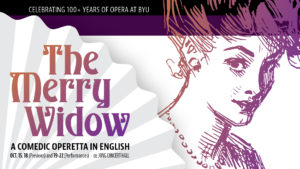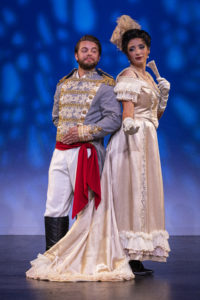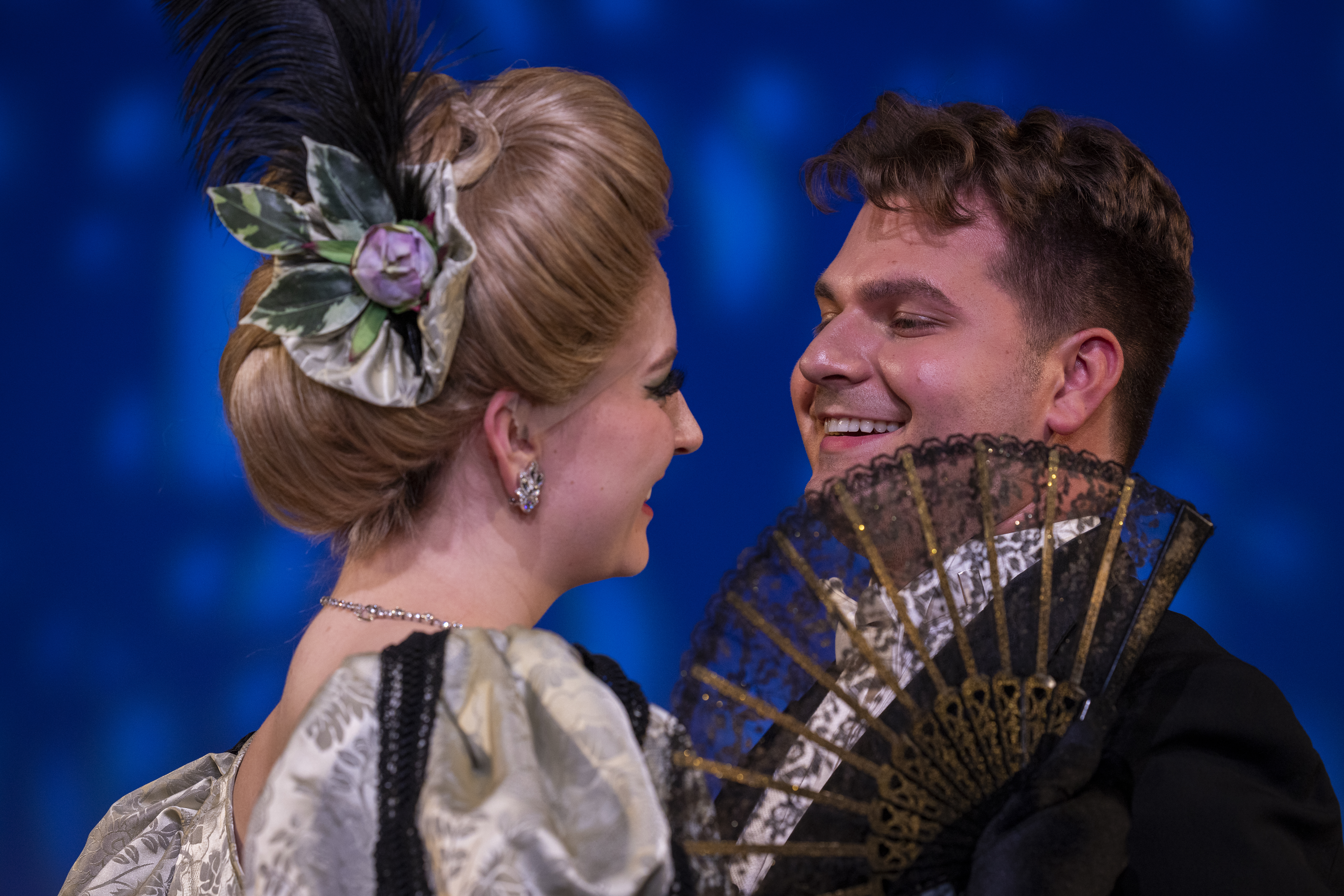PROVO — BYU’s production of The Merry Widow is that rare thing: an opera with mass appeal. Music lovers will relish the expertly performed score. Newcomers to opera will appreciate the accessible story (in English!). Opera buffs will enjoy the staging and the chance to revisit an old favorite. Theatre lovers will delight in the technical designs. And everyone can enjoy the comedy that has made audiences laugh at The Merry Widow for over a century.

The title character of The Merry Widow is Hannah Glawari, whose fabulous wealth makes her one of the richest women in Europe. Because she lives in Paris, officials in her native country, the tiny fictional nation of Pontevedrin in Eastern Europe, are worried that if she marries a foreigner, then her money will leave the nation, thereby bankrupting Pontevedrin. The Count of Zeta, the ambassador of Pontevedrin to France, puts fellow diplomat Count Danilo Danilovitsch, in charge of ensuring that she marries a Pontevedrin. Unbeknownst to him, Danilo and Hannah had a previous relationship, and they still have feelings for one another. However, Danilo cannot bring himself to say the words, “I love you,” to her, and she refuses to marry him without a profession of love. Meanwhile, the Count of Zeta’s wife, Valencienne, is unhappy being married to a much older man and flirts with the French Count de Rosillon, Camille. When Valencienne and Camille are nearly caught in a compromising situation, Hannah saves both people’s honor by announcing that she has decided to marry Camille, much to the dismay of the Pontevedrins.

The story sounds more complex than it really is. These events unfold over three acts and two and a half hours, and the story is very understandable, mostly because the core plot shares a lot of tropes with many romantic comedy films. The libretto (originally written in German by Viktor Léon and Leo Stein, translated by Lawrence and Jean Vincent, and adapted and updated by Shea Owens and Pollyanna Eyler) is quite funny, and the reliance on stock characters ensures that the story stays comprehensible. What The Merry Widow lacks in sophistication, it makes up with charm.
Director Shea Owens kept the tone of the production light-hearted. For example, he gives “Foolish, Foolish Cavalier” some humorous physicality by having Danilo (played by Logan Reid) act out the song. Likewise, the intrigue when Danilo attempts to discover the owner of the fan led to a series of comic scenes that got increasingly loud laughter from the audience. Most impressive, though, was Owens’s skill in staging both complex group scenes — such as a lovely stage picture during Hanna’s “Vilja Song” — and intimate duets or solo scenes. The movement in smaller scenes organically filled the space and prevented the actors from appearing diminished on the large stage. The only directorial deficit was the tendency for the performers to deliver their spoken dialogue to the audience, instead of looking at and engaging with one another.
Still, audiences should not expect much naturalistic acting in The Merry Widow. Opera as an art form had already existed for hundreds of years before theatre audiences started expecting realistic stage acting. But the performances can still be compelling, especially when coupled with the strong vocals in this production. Reid gives the most nuanced performance, and he is well cast as the leading man in a romantic comedy. The glint in Reid’s eye during the Act 1 scenes between Danilo and Hanna showed that Danilo knew that he could woo Hanna — and seemed to let the audience in on the secret, too. Additionally, Reid’s vocal performance cannot be faulted. Every note sounds rich, and his vibrato enhances the notes and gives his songs a unifying sound.
As the title character, Cristy Ruiz has mastered both the technical demands of the role and the art of conveying emotion solely with her voice. The “Vilja Song” is the prime example of her exquisite vocal technique; yes, she sang the song in a soothing manner, but the subtle adjustments Ruiz made to her singing gave the moment an undercurrent of anguish that revealed much about Hanna’s emotional state. In many of her songs, Ruiz singlehandedly elevated Franz Lehár’s score and made its strengths obvious.
As Camille, Matthew Paez gives an engrossing performance. Paez is not just an opera singer; he is a conduit for timeless music. He pulls the notes from a higher plane of existence and shares them with his audience. His pure, tenor voice is simultaneously powerful and comforting to listen to. Paez’s acting chops are also praiseworthy, and he is an asset to every scene he appears in. His glee when the women of Maxim’s fawned over him, or the playful flirting scenes with Valencienne (played by Ellie Niver) made Camille a favorite character of the opera.
Stephen Dell’Aversano’s costume designs (courtesy of the Tri-Cities Opera Company) did much to establish the time period of the show. The tuxedos for the men and the long ball gowns for the women gave the entire production an air of class and elegance. Dell’Aversano dressed Danilo in a particularly dashing costume for the second act, with a military jacket, sash, and high boots, which all contributed to the character’s status as a romantic lead. Additionally, the Eastern European folk dance costumes and the dresses for the dancers at the restaurant gave a splash of color and liveliness to the second and third acts. The only costume faults were the white shoes that Valencienne wore in the final act (which mismatched her dark stockings) and the military-style riding boots that Danilo wore with his tuxedo in the first act. But I am willing to forgive a two minor choices in footwear because all the other costume pieces were so sophisticated. The sets, designed by Robert Little (and constructed by Utah Festival Opera and Musical Theatre) were lavish, and all three sets gave the illusion of depth. The embassy ballroom for the first act had an opulent style and was accented with Ionic and Corinthian columns, making it particularly eye-catching.
All the singers and musicians serviced the score well. It is easy to get swept away in the loveliness of the duets or the rhythm of the waltzes. The lyrics are surprisingly clever; they do not feel like translations, and the rhymes rarely felt forced. However, there were moments when the 88-piece orchestra (led by conductor Kory Katseanes) overpowered the singers — even the entire cast was singing.
BYU’s production of The Merry Widow is a lot of things: escapist fun, a luxurious costume piece, a classy (and budget-friendly) date night, a sublime musical experience, and more. The Merry Widow is a production that can win over nearly anyone who gives it a chance. Its flaws are few and fleeting, and its strengths are impressive. I recommend that Utah audiences make room in their schedule to see The Merry Widow this week.
[box]The Merry Widow plays nightly at 7:30 PM through October 22 at the de Jong Concert Hall in the Harris Fine Arts Center on the campus of Brigham Young University. Tickets are $10-16. For more information, visit arts.byu.edu.[/box]
